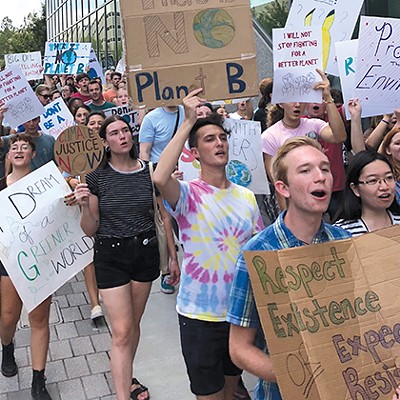Global Climate Marches took place in Oklahoma City and around the world on the weekend before the Paris Climate Summit began Nov. 30. According to the Global Climate March website, 780,000 people participated in 2,300 marches in 175 countries.
The message of the marches was, “We demand a climate treaty in line with the realities of science and the principles of justice.” Marchers also sought agreement to leave most remaining fossil fuels in the ground and finance a fair global transition to 100 percent renewable energy by 2050.
Coal is the dirtiest fossil fuel, producing carbon dioxide (CO2), sulfur dioxide and other particulates contributing to asthma, emphysema and lung cancer. While transported by rail, 1 percent of coal’s mass is lost into the atmosphere as coal dust, further contributing to lung irritation and disease. Strip mining coal is an environmental disaster.
Production of electricity must be shifted to solar and wind power. These do not cause earthquakes, global warming, climate change or lung disease or require thousands of years of safe storage of radioactive wastes.
People and industries can reduce their carbon footprint by conserving energy, insulating buildings, installing LED lighting, driving hybrid and electric vehicles and reducing meat consumption. Geothermal systems heat and cool buildings with less energy.
Emissions of CO2 are warming the atmosphere and the oceans. Sea levels are rising as polar ice melts, but also because water expands as it warms. Oceans become acidified as they absorb CO2, causing the bleaching of coral reefs and reducing the reproductive capacity of fish that serve humanity as food.
Business schools teach that healthy economies depend upon economic growth. Growth is considered good in the production of energy, food, products and services, particularly as human numbers have risen from 3 billion in 1960 to 7 billion today and perhaps 9 billion within this century. Economic equations, however, do not factor in costs of degrading quality of air, water, land or natural systems supporting life. Because we live on a finite planet, unlimited growth has serious consequences.
Zoologists tell us that we are, right now, living in the sixth great extinction of species on earth. The previous five had natural causes. The most recent was 65 million years ago when an enormous asteroid slammed into the Gulf of Mexico. Dense clouds of dust encircled the earth, blocking sunlight, killing vegetation and chilling earth to deadly levels. The majority of plants and animals living then disappeared. Goodbye, dinosaurs.
The current era of extinctions is considered anthropogenic, or caused by humans. Beginning some 10,000 years ago, human societies began displacing other species. Our impact has grown dramatically with industrialization, population expansion, increased consumption per capita and disposal of wastes into the air, water and land. Estimates are that 50,000 species of plants, animals, insects and microbial life go extinct every year as a result of human impact. Virtually every religious tradition emphasizes humanity’s responsibility to be stewards of nature and the environment — God’s creation.
For all these reasons, humanity must fundamentally change our ways or watch the continued destruction of natural systems supporting life.
Nathaniel Batchelder is director of The Peace House in Oklahoma City.













